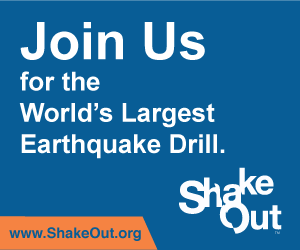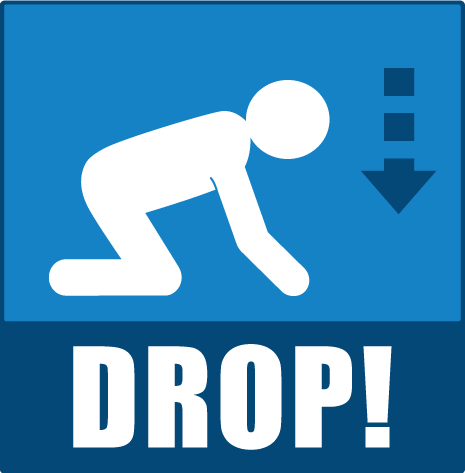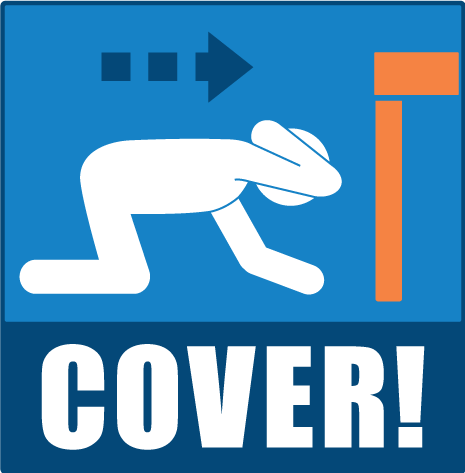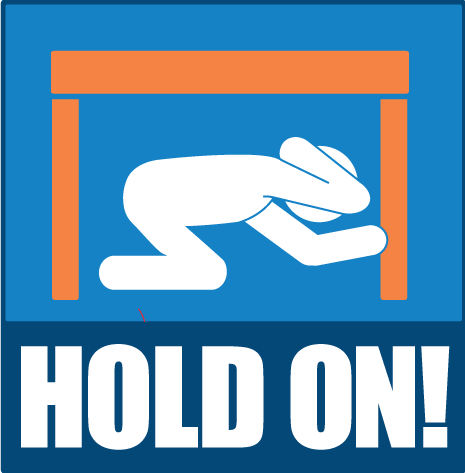what is the safest place to hide in case of earthquake

Earthquake Prophylactic Video Series: Unproblematic videos demonstrating what to practice to protect yourself in various situations (near a table, no table nearby, in a theater/auditorium, at the shore, while driving, and more to come).
Los Angeles Canton Firefighters demonstrate Driblet, Cover, and Concur On
Learn nearly Drib, Embrace, Hold On from MySafeLA.org
OFFICIAL RESCUE TEAMS from the U.S. and other countries who have searched for trapped people in collapsed structures around the world, likewise as emergency managers, researchers, and school safety advocates, all hold that "Drop, Cover, and Hold On" is the advisable activeness to reduce injury and death during earthquakes. Methods similar continuing in a doorway, running outside, and the "triangle of life" are considered dangerous and are not recommended (encounter below).
Topics addressed beneath include:
- What to do wherever y'all are when shaking begins
- Why experts recommend Drop, Comprehend, and Concord On
- What experts do not recommend you practise during an convulsion
WHAT TO Exercise IMMEDIATELY WHEN SHAKING BEGINS
Your past experience in earthquakes may give you a false sense of safety; you didn't do anything, or yous ran outside, yet you survived with no injuries. Or perhaps y'all got under your desk, and others thought y'all overreacted. However, you probable have never experienced the kind of strong shaking that is possible in much larger earthquakes: sudden and intense back and forth motions of several feet per 2nd will cause the floor or the footing to wiggle sideways out from under yous, and every unsecured object around you lot could topple, autumn, or become airborne, potentially causing serious injury. This is why yous must larn to immediately protect yourself after the start jolt… don't wait to see if the earthquake shaking is stiff!
In Nearly situations, you will reduce your chance of injury if you:
 | DROP where you are onto your easily and knees. This position protects you from being knocked downwardly and also allows you to stay depression and clamber to shelter if nearby. |
 | Cover your caput and neck with one arm and hand
|
 | Agree ON until shaking stops
|
Wherever yous are, protect yourself! Information technology is of import to think about different scenarios in which an earthquake tin suddenly strike. What if you are driving, in a theater, in bed, at the beach, etc.? Step v of the Vii Steps to Earthquake Safety describes what to do in diverse situations, then y'all know what to do no matter where you are when yous feel convulsion shaking.
Persons with Disabilities: See EarthquakeCountry.org/accessibility for recommendations for people who employ wheelchairs, walkers, or who are unable to driblet to the ground and get up again without assistance.
WHY RESCUERS AND EXPERTS RECOMMEND Driblet, COVER, AND Concord ON
Trying to movement during shaking puts you at risk: Earthquakes occur without any alert and may exist so tearing that yous cannot run or crawl; you lot will most likely exist knocked straight to the ground. Information technology is best to drop earlier the earthquake drops you and find nearby shelter or use your arms and easily to protect your caput and neck. "Drop, Cover, and Hold On" gives you the best overall run a risk of speedily protecting yourself in an earthquake… even during quakes that cause furniture to movement about rooms and in buildings that might ultimately plummet.
The greatest danger is from falling and flying objects: Studies of injuries and deaths acquired by earthquakes over the last several decades show that you lot are much more than likely to be injured by falling or flying objects (TVs, lamps, glass, bookcases, etc.) than to die in a collapsed building. "Drop, Embrace, and Concur On" (equally described above) will protect you from most of these injuries.
If there is no article of furniture nearby, you can still reduce the chance of injury from falling objects past getting down next to an interior wall and covering your head and neck with your arms (exterior walls are more likely to collapse and accept windows that may interruption). If y'all are in bed, the best matter to do is to stay there and cover your head with a pillow. Studies of injuries in earthquakes prove that people who moved from their beds would not have been injured if they had remained in bed.
Y'all can also reduce your chance of bodily injury or harm to your belongings by securing them in the kickoff identify. Secure top-heavy article of furniture to walls with flexible straps. Use earthquake putty or velcro fasteners for objects on tables, shelves, or other piece of furniture. Install safety latches on cabinets to keep them closed. Instructions for how to "secure your space" are at EarthquakeCountry.org/Step1.
Edifice collapse is less of a danger: While images of collapsed structures in earthquakes around the world are frightening and get the most attention from the media, most buildings do not collapse at all. Few buildings actually fail completely. In convulsion prone areas of the U.South. and in many other countries, strict edifice codes have worked to greatly reduce the potential of construction collapse. However, there is the possibility of structural failure in certain building types, particularly unreinforced masonry (brick buildings), and some structures synthetic before the latest edifice codes. Rescue professionals are trained to empathize how these structures collapse in order to identify potential locations of survivors within "survivable void spaces."
The primary goal of "Drop, Cover, and Agree On" is to protect you lot from falling and flight debris and other nonstructural hazards, and to increase the chance of your ending up in a Survivable Void Infinite if the building actually collapses. The space under a sturdy table or desk is likely to remain even if the building collapses — pictures from around the world prove tables and desks continuing with rubble all around them and fifty-fifty belongings up floors that have collapsed. Experienced rescuers agree that successfully predicting other safe locations in accelerate is nearly impossible, as where these voids volition be depends on the direction of the shaking and many other factors. (See "triangle of life" below.)
The Simply exception to the "Drop, Encompass and Hold On" rule is if you are in a land with unengineered construction, and if you are on the basis flooring of an unreinforced mud-brick (adobe) building with a heavy ceiling. In that case, you should endeavor to move quickly exterior to an open space. This cannot be recommended as a substitute for building earthquake-resistant structures in the first place!
WHAT RESCUERS AND EXPERTS *Do NOT* RECOMMEND YOU DO DURING AN EARTHQUAKE
Based on years of inquiry near how people are injured or killed during earthquakes, and on the experiences of U.S. and international search and rescue teams, these three deportment are not recommended to protect yourself during earthquakes:
Do Non run outside or to other rooms during shaking: The area near the exterior walls of a building is the most dangerous place to exist. Windows, facades and architectural details are oft the starting time parts of the building to collapse. To stay abroad from this danger zone, remain within if you lot are inside and outside if yous are exterior. As well, shaking can be then strong that y'all may not be able to move far without falling down, and objects may unexpectedly fall or be thrown at you. Injuries tin can be avoided if you drib to the ground before the earthquake drops you lot.
Exercise NOT stand in a doorway: One enduring image from the aftermath of a California earthquake is that of a complanate adobe home of which only a doorframe is left standing. From this came our belief that a doorway is the safest place to be during an convulsion. True — if you alive in an one-time, unreinforced adobe house or some older wood-frame houses. In modernistic homes, doorways are no stronger than whatever other function of the house. Doorways do not protect you from the nigh likely source of injury — falling or flying objects. You also may not be able to caryatid yourself in the door during strong shaking. You are safer under a table.
world wide web.earthquakecountry.org/dropcoverholdon/
Ask them to send this link to everyone they sent the "triangle" email, and to the person who sent information technology to them. Thank you!
Do NOT get in the "triangle of life": In contempo years, an e-mail has been circulating which describes an alternative to the long-established "Drop, Cover, and Concord On" advice. The so-called "triangle of life" and some of the other actions recommended in the e-mail are potentially life threatening, and the credibility of the source of these recommendations has been broadly questioned (come across links in the next section).
The "triangle of life" communication (always become next to a tabular array rather than underneath it) is based on several wrong assumptions:
- buildings always collapse in earthquakes (wrong — specially in adult nations, and flat "pancake" plummet is rare anywhere);
- when buildings plummet they e'er shell all furniture inside (wrong- people Practise survive nether furniture or other shelters);
- people can always conceptualize how their building might collapse and the location of survivable void spaces (wrong- the direction of shaking and unique structural aspects of the edifice make this about impossible) ; and
- during potent shaking people tin can move to a desired location (incorrect- potent shaking can make moving very difficult and dangerous).
Some other recommendations in the "triangle of life" e-mail are too based on wrong assumptions and are very hazardous. For example, the recommendation to get out of your car during an earthquake and prevarication down next to it assumes that there is always an elevated pike above you that will autumn and crush your car. Of form, there are very few elevated freeways, and lying next to your car is very dangerous considering the car can move and shell you, and other drivers may non see you on the ground!
Paper and Online articles:
| Why 'Driblet, Cover and Agree On' is still the best advice
| Snopes.com (internet rumor site) analysis
Stories about the advocate of the "triangle of life" theory:
| A 9/11 Phony (four-day series of manufactures)
| Sept. eleven hero's story questioned
PRACTICE THE RIGHT Thing TO Practice… IT COULD Salve YOUR LIFE
You will be more probable to react quickly when shaking begins if you take really skillful how to protect yourself on a regular basis. A cracking time to practice "Driblet, Comprehend, and Hold On" is by participating in a Dandy ShakeOut Earthquake Drill (each October in most areas).

Source: https://www.earthquakecountry.org/dropcoverholdon/
0 Response to "what is the safest place to hide in case of earthquake"
Post a Comment